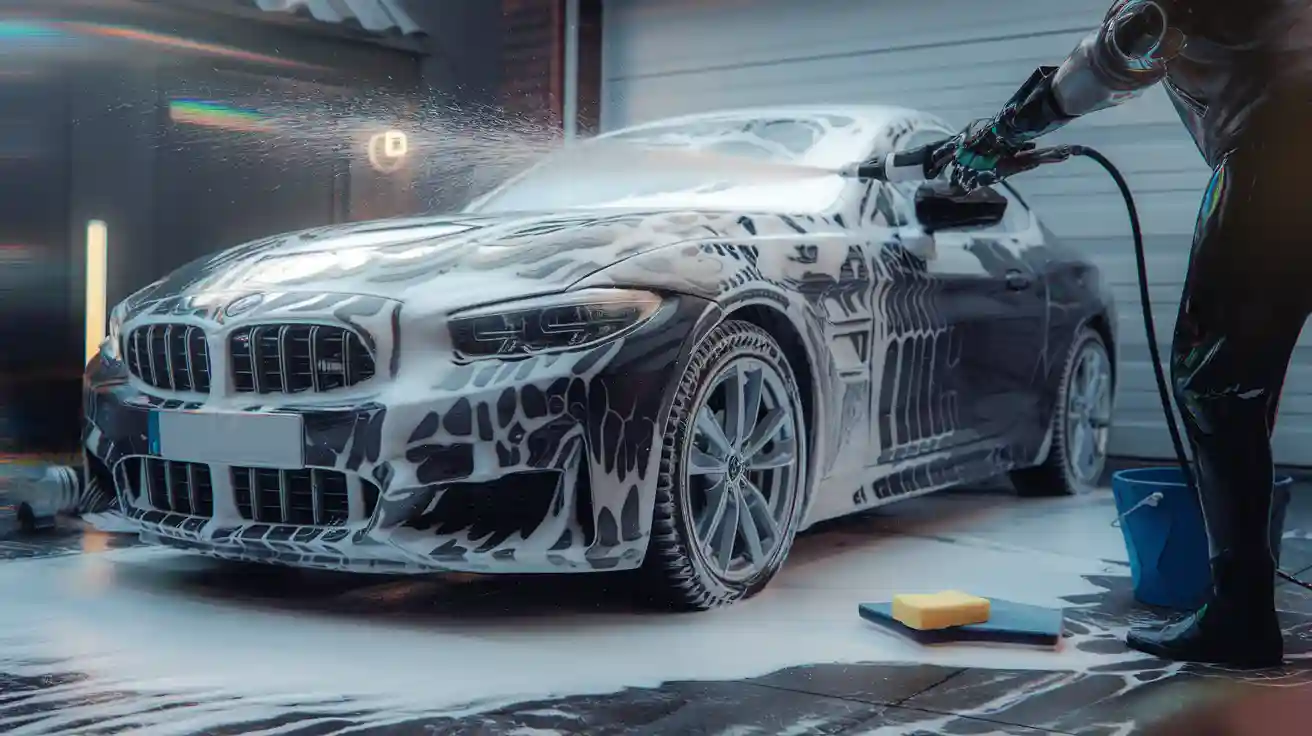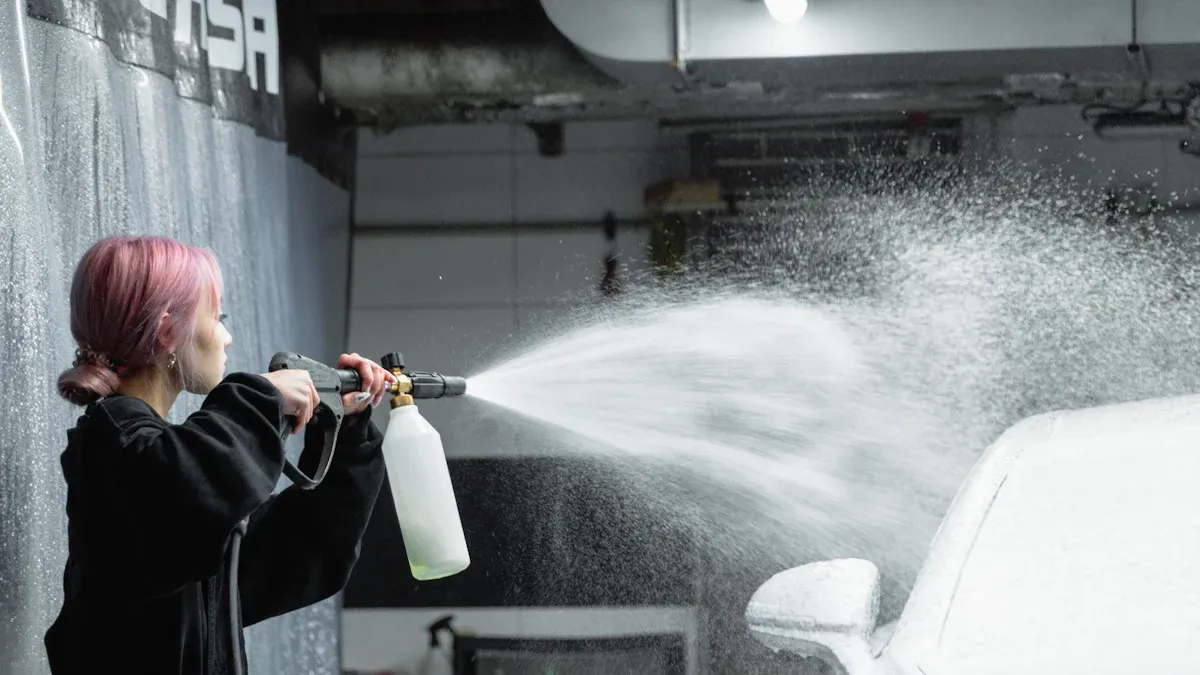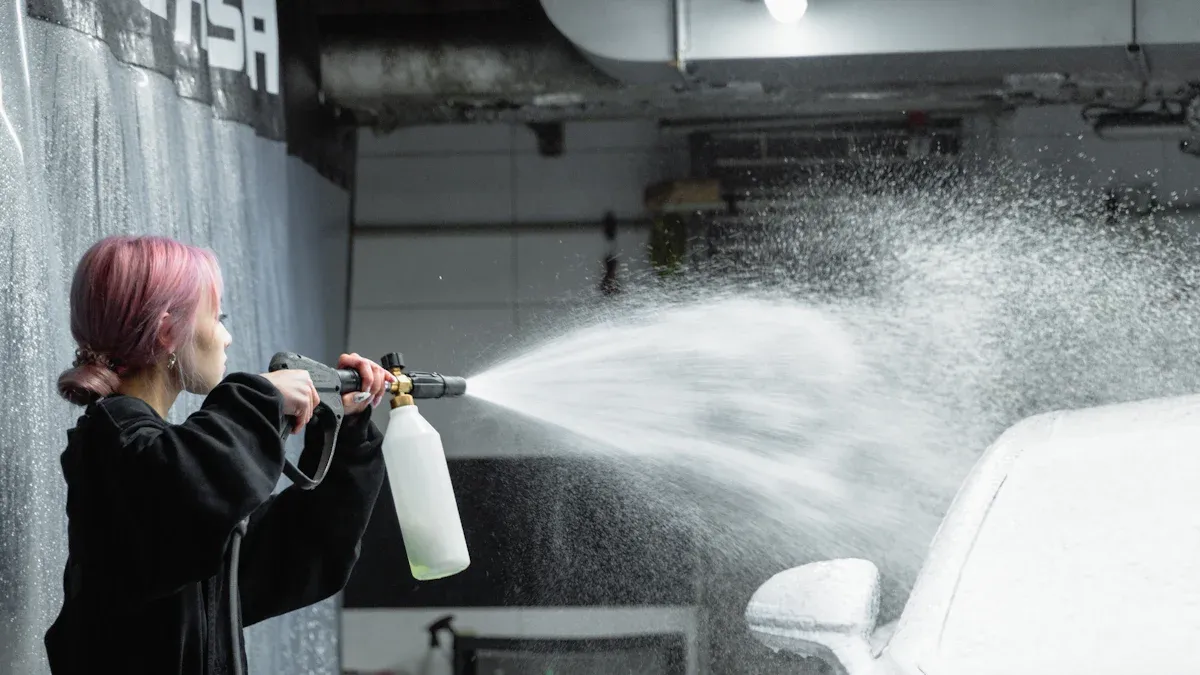
Cleaning foam spray for car is a game-changer when it comes to washing your vehicle. It creates a thick, soapy layer that clings to your car, effectively loosening dirt and grime before you even touch it. This makes cleaning faster and safer for your car’s paint. Did you know using a cleaning foam spray for car can save you up to 30% of your cleaning time? Plus, it reduces micro-scratches by 40% compared to traditional methods. With cleaning foam spray for car, you can achieve a professional-quality wash at home while protecting your car’s finish. It’s no surprise that 75% of car owners prefer foam car wash systems over water washes!
Key Takeaways
Foam spray can cut cleaning time by 30% and reduce scratches by 40%.
Rinse your car first to wash off loose dirt. This keeps the paint safe and helps the foam stick better.
Pick a good pH-neutral foam to protect your car's surface. The right foam makes cleaning easier and more professional.
Use a soft microfiber mitt to scrub without scratching. Rinse the mitt often to remove dirt and avoid damage.
Dry your car with microfiber towels when done. You can also add wax for extra shine and protection.
Tools and Products for Cleaning Foam Spray for Car
Essential tools for foam spray car cleaning
To get the most out of your snow foam car wash, you’ll need the right tools. A foam cannon or snow foam cannon is a must-have. These devices attach to your pressure washer and create that thick, clinging foam that makes cleaning so effective. If you don’t have a pressure washer, a foam gun is a great alternative. It connects to your garden hose and still delivers decent foam coverage.
You’ll also need a high-quality microfiber mitt for scrubbing. This tool is gentle on your car’s paint and helps lift dirt without causing scratches. A bucket with a grit guard is another essential. It keeps dirt particles at the bottom, so they don’t end up back on your mitt. Finally, don’t forget microfiber towels for drying. They’re super absorbent and leave your car streak-free.
Tip: Some users find foam guns reduce scratching during washing, while others prefer rinseless washes for better lubrication. Experiment to see what works best for you!
Choosing the right snow foam and equipment
Picking the best snow foam and equipment can make or break your car wash spray foam experience. Start with a high-quality snow foam that’s designed for your car’s needs. A pH-neutral snow foam is ideal because it’s gentle on your car’s paint and won’t strip away wax. The consistency of the foam matters too. It should be thick enough to cling to your car but not so thick that it doesn’t run off.
When it comes to equipment, a snow foam cannon is your best bet for producing rich, even foam. Make sure your pressure washer meets the cannon’s requirements for pressure and flow. If you’re using a foam gun, check that it’s compatible with your garden hose. For the foam mixture, a 1:16 ratio works well for most cars, but you can adjust it based on how dirty your vehicle is.
The automotive cleaning market is booming, with products like snow foam and foam cannons driving demand. This growth reflects how much car owners value effective and professional-quality cleaning tools. By investing in the right products, you’ll not only save time but also protect your car’s finish.
Preparing Your Car for Snow Foam Cleaning

Pre-rinsing to remove loose dirt
Before you dive into using a foam cannon, it’s essential to pre-rinse your vehicle. This step might seem simple, but it’s one of the most important parts of the cleaning process. A quick rinse with low-pressure water removes loose dirt, dust, and debris from the surface. By doing this, you reduce the risk of dragging abrasive particles across your car’s paint when you start scrubbing. Think of it as giving your car a clean slate before applying the snow foam pre-wash.
Pre-rinsing also helps improve the adhesion of the foam. When the surface is free of loose contaminants, the foam can cling better, allowing its surfactants to work more effectively. These surfactants lift grime and road salt without you needing to scrub right away. This not only makes the cleaning process faster but also safer for your car’s finish. If you’re in a dusty or salty environment, pre-rinsing becomes even more critical to prevent buildup that could harm your paint.
Tip: Always start rinsing from the top of the car and work your way down. This ensures dirt flows downward and doesn’t settle back on areas you’ve already cleaned.
Setting up the foam cannon or foam gun
Now that your car is prepped, it’s time to set up your foam cannon. For the best results, use a pressure washer with at least 1.75 GPM and 1,900 PSI. These specifications ensure the foam is thick enough to stick to your car and loosen grime effectively. Attach the foam cannon to your pressure washer and adjust the knobs to control the soap and nozzle settings. This lets you customize the foam consistency based on your car’s needs.
If you’re using a foam gun instead, connect it to your garden hose. While it won’t produce foam as thick as a foam cannon, it still provides decent coverage. For both tools, using distilled water instead of tap water can improve foam quality. Hard water contains minerals that can interfere with the foaming process, so distilled water ensures a smoother application.
Pro Tip: Test the foam on a small section of your car first. This helps you fine-tune the settings for optimal coverage and soap usage.
Applying Snow Foam to Your Car

How to apply foam evenly
When using snow foam, cover the whole car with suds. This helps loosen dirt and grime evenly for better cleaning. Hold the foam cannon at a slight angle, about 2-3 feet away. Start spraying from the top and move downward. Gravity helps the foam spread and cover all areas.
Spray a thick layer of foam that sticks to the car. The foam traps dirt and makes cleaning easier. Move the cannon in smooth, overlapping motions to avoid missing spots. Focus on areas like the front grille, wheel arches, and lower panels. These spots usually collect the most dirt. If using a foam gun, follow the same steps, but the foam may be thinner.
Tip: Adjust the foam cannon nozzle to change the spray shape. Use a wide spray for big areas and a narrow spray for tight spots.
Letting foam sit without drying
After spraying snow foam, let it sit for a few minutes. This gives the foam time to break down dirt and grease. But don’t let it dry, or it could leave streaks or marks.
Here’s how to keep foam from drying:
Don’t apply foam in direct sunlight, as heat dries it fast.
Watch the foam closely. Rinse it off if it starts drying.
Use pH-neutral foam, which sticks better and dries slower.
Foam clinging to the car boosts its cleaning power. It covers 50% more than regular sprays, reaching tricky spots. The longer it stays, the better it removes tough grime. This makes your car cleaner and reduces scrubbing time.
Note: Too much foam can affect other cleaning products. Use just enough to cover the car without overdoing it.
By following these tips, you’ll get the most out of snow foam and clean your car safely and thoroughly.
Scrubbing and Rinsing the Car
Using a microfiber mitt for scrubbing
Once your car is covered in foam, it’s time to scrub away the dirt. A microfiber mitt is your best friend for this step. Unlike traditional sponges, microfiber mitts are designed to be gentle on your car’s paint. They glide smoothly over the surface, reducing the risk of scratches or swirl marks. Plus, they’re excellent at trapping dirt and debris, keeping them away from your car’s finish as you clean.
To get started, dip your microfiber mitt into a bucket of clean water with soap. Work in small sections, starting from the top of the car and moving downward. This ensures you’re not dragging dirt from the lower, dirtier areas onto the cleaner upper sections. Use light, circular motions to lift grime effectively. Don’t forget to rinse the mitt frequently in a separate bucket with a grit guard to keep it free of debris.
Why microfiber? Professionals swear by microfiber mitts because they distribute soap evenly and provide a thorough clean. Their unique fibers make them a superior choice for achieving a scratch-free finish.
Rinsing thoroughly to remove foam and dirt
After scrubbing, it’s crucial to rinse your car thoroughly. Foam cannon residue, along with the loosened dirt, needs to be washed away completely. Start at the top of the car and work your way down, using a steady stream of water. This method ensures that dirt flows downward and doesn’t settle back onto cleaned areas.
If you’re using a pressure washer, adjust it to a low-pressure setting to avoid damaging the paint. For the final rinse, consider using demineralized water. It prevents streaks and water spots, leaving your car with a spotless finish. Studies show that active foams, while effective at breaking down grease, can harm automotive coatings if not rinsed off promptly. So, don’t skip this step!
Pro Tip: Rinse your car in the shade or during cooler parts of the day. This prevents water and foam from drying too quickly, which can leave unsightly marks.
By following these steps, you’ll ensure your car is not only clean but also protected from potential damage during the washing process.
Drying and Adding Finishing Touches
Drying the car with microfiber towels
Once your car is rinsed, drying it properly is the next step to achieving that streak-free shine. Grab a microfiber towel designed specifically for drying cars. These towels are game-changers. They’re super absorbent and can hold a lot of water, which means you’ll spend less time drying and more time admiring your clean car.
Start at the top of your car and work your way down. Gently pat the surface instead of dragging the towel. This method prevents scratches and keeps your car’s paint looking flawless. Pay extra attention to areas where water tends to pool, like side mirrors and door handles.
Microfiber towels, like the Microfiber Twisted Car Drying Towel, are highly effective because of their twisted microfiber technology. This design boosts water retention, making them perfect for drying your car quickly. Plus, they help prevent water spots, which can ruin the look of your freshly cleaned car. Many car owners swear by these towels for their efficiency and reliability.
Pro Tip: Use multiple towels if needed. A dry towel absorbs water better than one that’s already soaked.
Optional waxing for added shine and protection
If you want to take your car cleaning routine to the next level, consider applying a coat of wax. Waxing not only enhances your car’s shine but also adds a protective layer to its paint. This layer helps repel dirt, water, and even harmful UV rays.
Choose a high-quality car wax that suits your needs. Liquid waxes are easy to apply, while paste waxes offer longer-lasting protection. Apply the wax in small sections using a foam applicator pad. Use circular motions and follow the product’s instructions for the best results. Once the wax hazes over, buff it off with a clean microfiber towel.
Waxing doesn’t just make your car look great—it also makes future cleaning easier. Dirt and grime won’t stick as easily, and your car will maintain its shine for weeks.
Did you know? Waxing can extend the life of your car’s paint by protecting it from environmental damage.
By drying your car thoroughly and adding a layer of wax, you’ll keep it looking like it just rolled out of the showroom.
Common Mistakes When Using Cleaning Foam Spray for Car
Letting foam dry on the car
A big mistake is letting snow foam dry on your car. Dried foam can leave streaks or marks that are hard to clean. These marks can ruin your car’s look and harm the paint over time. To prevent this, wash your car in the shade or when it’s cooler outside. Watch the foam closely and rinse it off before it dries. If it dries too fast, add more water to your foam mix to slow it down.
Tip: Use pH-neutral snow foam. It dries slower, giving you extra time to clean, especially on sunny days.
Using incorrect products or tools
Wrong products or tools can damage your car or give poor results. For example, dish soap can remove wax, and rough sponges can scratch the paint. Always pick high-quality snow foam made for cars. Pair it with tools like a foam cannon or foam gun for even coverage and better cleaning.
Here’s a simple guide to avoid mistakes and fix them:
Mistake |
Solution |
|---|---|
Rushing the Process |
Clean, dry, and follow curing times carefully. |
Over-Applying the Coating |
Use thin layers instead of thick ones for a smooth finish. |
Poor Surface Preparation |
Clean and decontaminate fully for better coating adhesion. |
Inadequate Masking |
Cover nearby areas to avoid overspray and keep lines neat. |
Skipping the pre-rinse step
Skipping the pre-rinse step can make cleaning harder and less safe. Pre-rinsing removes loose dirt and dust, lowering the chance of scratches when applying snow foam. Without rinsing, dirt can rub into the paint and cause damage. Always rinse your car from top to bottom before using foam. This helps the foam work better on a cleaner surface.
Pro Tip: Use low-pressure water for rinsing. This keeps dirt from being pushed deeper into the paint, making cleaning safer and easier.
By avoiding these mistakes, you’ll get better results with snow foam and keep your car looking great.
Using snow foam to clean your car is a simple yet effective way to achieve professional results at home. Start by pre-rinsing to remove loose dirt, then apply an even layer of foam with a foam cannon or gun. Let it sit for a few minutes, scrub gently with a microfiber mitt, and rinse thoroughly. Finish by drying your car with microfiber towels and adding a layer of wax for extra shine and protection.
Snow foam not only makes cleaning easier but also protects your car’s paint from scratches and damage. Its thick, clinging formula reaches every corner, lifting dirt without harsh scrubbing. By following these steps, you’ll keep your car looking spotless and shiny for longer.
So, why not give snow foam a try? Your car will thank you for it!
FAQ
What is snow foam, and why should I use it?
Snow foam is a pre-wash cleaning solution that creates thick suds to loosen dirt on your car. It reduces the need for scrubbing, which helps protect your car’s paint from scratches. It’s a simple way to get a professional-quality clean at home.
Can I use snow foam without a pressure washer?
Yes, you can! A foam gun that attaches to your garden hose works as an alternative. While it doesn’t produce foam as thick as a foam cannon, it still provides decent coverage for effective cleaning.
Tip: Use distilled water with a foam gun for better foam quality.
How often should I use snow foam on my car?
You can use snow foam every time you wash your car. For most people, washing once every two weeks works well. If your car gets dirty quickly, you might need to clean it more often to maintain its shine.
Does snow foam remove wax or sealant?
Most pH-neutral snow foams won’t strip wax or sealant. They’re designed to clean gently while preserving protective layers. Always check the product label to ensure it’s safe for your car’s finish.
Can I use dish soap instead of snow foam?
No, dish soap isn’t safe for your car. It can strip wax and damage the paint. Always use a high-quality snow foam specifically made for cars to protect your vehicle and achieve the best results.
Note: Investing in the right products saves you time and keeps your car looking great.








0 comments